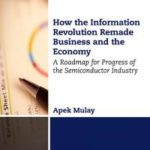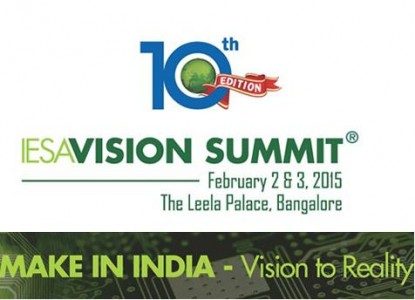It was a pleasure to attend the 10th annual India Electronics and Semiconductor Association (IESA) Vision Summit held on February 2 and 3, 2015 at Leela Palace in Bangalore, India. The conference offered a great opportunity to network with the stake holders involved in making a bright vision become a reality sooner for Indian Electronic & Semiconductor Devices Manufacturing (ESDM) sector. Taking into consideration the national importance of domestic manufacturing for reducing India’s current account deficits, it was good to know that the realization has finally dawned on government, industry, and academia that bringing this vision to fruition will avoid an economic calamity.
The event started with a welcome address by IESA president M N Vidyashankar who is also a retired Indian Administration Service (IAS) officer. It was followed by theme address on Make in India – Vision to Reality by Padma Bhushan Dr. K Radhakrishnan who is former chairman of ISRO. Dr. Radhakrishnan has also played a critical role in success of Mangalyan Mission, which was a landmark achievement by India in low cost space technology. The cost for this mission was lower than the cost for making the Hollywood movie Gravity. The inauguration ceremony included several dignitaries including
1.Mr. Siddaramaiah, Chief Minister, Govt. of Karnataka
2.Dr. Omkar Rai, Director General, STPI, Govt. of India
3.Sonny Kunnakkat, Chief of Staff, Applied Materials India
4.Rabindra Srikantan, Managing Director, ASM Technologie Ltd.
5.Padma Bhushan Dr. K Radhakrishnan, Former Chairman, ISRO
6.Grant Kuo, Managing Director, MediaTek India
7.Ashok Chandak, Chairman, IESA
8.M N Vidyashankar, President, IESA
There were a total of seven keynote addresses in two days from Manish Muthal, Krishna Yariagadda, Grant Kuo, Kumud Srinivasan, Dr. Ronald Black, Dr. BVR Mohan Reddy and Rajiv C Mody. The two-day event also has six panel discussions on various important topics. As much as I would like to tell you all about all of it, this blog will focus on those panel discussions.
Panel Discussion 1: Transforming India – Movers & Shakers
This session was chaired by Mr. Randeep Singh Khokar and featured several speakers: Dr. Ajit T. Kalghatgi, Mr.Sudhir Hasija, and Dr. Suket Singhal. I received a reply from panelists to the following two questions based on topics in my newly released book Mass Capitalism: A Blueprint for Economic Revival about how India should ensure mitigation of counterfeit electronics in its supply chain. As part of my query, I reminded them of the fact that offshoring manufacturing to China has resulted in nearly 40% of DoD supply chain with counterfeit electronics thereby threatening national security of U.S.
The answer from Dr. Ajit T Kalghatgi was not very convincing, as there seemed to be no concrete solution offered to eliminate counterfeits. However, I have written about how globalization with free trade has resulted in problems of counterfeit electronics and what reforms in international trade policies could eliminate the introduction of these counterfeit electronics.
Since Mr. Sudhir Hasija had mentioned that 90% of his company’s exports were to developed countries, I was curious to know how much slowdown his business had experience due to slowing demand in developed world. Mr. Hasija acknowledged a slowdown in his business but said that his company compensates for the same by looking for opportunities elsewhere. Today, there is slowdown in global economy, which also includes a slowdown in China, offering clear evidence of failure of policies of globalization with free trade.
Panel Discussion 2: Fueling the Wheels of Change – the Essentials
This session was chaired by Professor Pankaj Chandra and with speakers Professor Rajat Moona, Sanjay Gupta, Ganesh Guruswamy, and Raja Manickam. In this session, speakers discussed the role played by key sectors in fueling the wheels of change set in motion by various favorable factors in the country and transforming India into a self-reliant global hub for electronics and semiconductors.
While I agree with the general consensus of the panel about increased need to collaboration between industry, government, and academia, I need to caution about the plans of making India a global manufacturing hub. I believe policies of globalization with free trade have resulted in relentless trade deficits, budget deficits, consumer debt, national debt, and high unemployment in United States.
The Macroeconomic loss due to these policies far outweigh the Microeconomic benefits from them. Hence, India should consider adopting free market policies in order to create a robust domestic ESDM eco-system which also makes it a self-reliant economy. History teaches us to learn from past mistakes of others to plan for a better future for ourselves. As a student of history of global semiconductor industry, I have explored where we went wrong and how to correct course to restore a broader prosperity.
Panel Discussion 3: States – The Fulcrum of ESDM Policy Implementation
The third session, chaired by Padma Shri Mohandas Pai, featured speakers Shri Aman Singh, Tanushree Deb Barma, Dr. Gopal Pillai, Shri Anand Rayate, and Shri G Srinivas. In early 2007, one of largest private sector companies in India, Reliance Industries, had plans to invest in semiconductor manufacturing. However, after 2008 financial crisis, these plans did not materialize for Reliance and were completely abandoned.
Given the past failures in establishing a state-of-the-art semiconductor manufacturing facility in India due to financial problems in global economy, I questioned the panel about the approach of their respective state governments (Chhattisgarh, Karnataka, Kerala, Maharashtra, and Odisha) in case of another financial crisis like 2008. However, my question was not given a due consideration with a statement that if there is a financial crisis in the US, then other Asian countries like S. Korea, Taiwan, etc. would invest in India.
As a macroeconomist, I already know that another global financial crisis far severe than 2008 crisis is on the horizon and it is certain to occur before the end of 2015. Hence, India should have an ESDM policy to ensure success of “Make in India” even if the foreign direct investments (FDIs) slowdown because of coming financial crisis.
Next week, I will share more about what I heard at this conference. In the meantime, let me know what you think that we as an industry need to do to make progress to a sustainable Indian ESDM sector. My hope is that the next IESA Vision Summit (4th & 5th February 2016) will actually transition to be the IESA Reality Summit.


Recent Comments